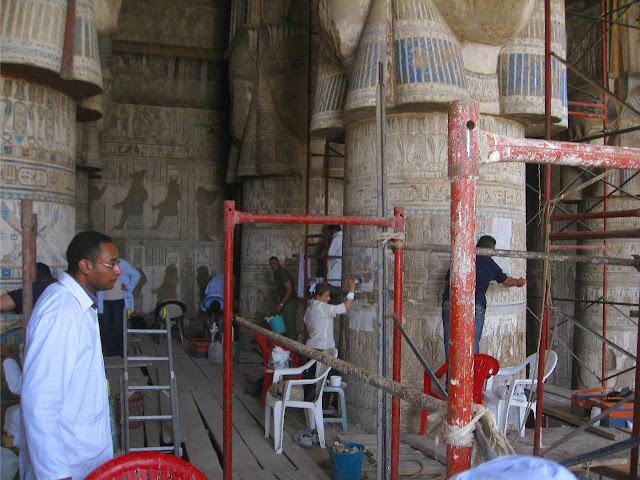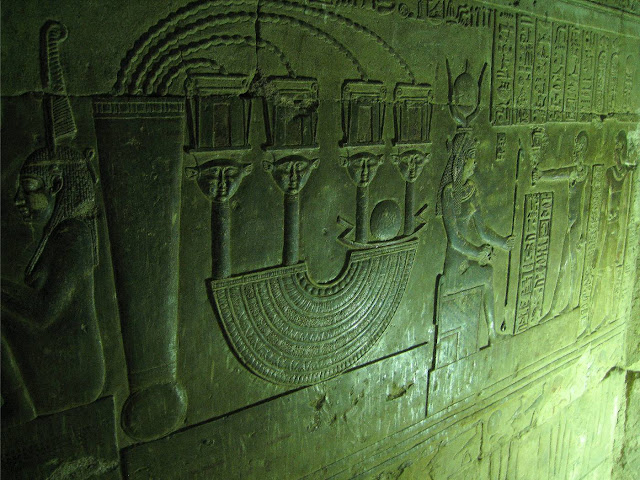Although I had visited Hathor's temple at least twice before, this visit proved that repeat visits can be as exciting as the first. Setting out early from Luxor, I had no idea what wonderful surprises were in store.
The first surprise was immediate upon our arrival. A new visitors centre has been built offering a very comfortable, air-conditioned theatre in which to watch an interesting introduction to the temple and its rites. It also offers the more mundane, but necessary, toilets -- for the price of a 1LE tip to the attendant. For all his (well-known) faults, Dr. Hawass must be credited for the creation of this and other visitor centres and small site museums across the country. They enrich the experience of visiting Egypt's extraordinary monuments.
The second and more astonishing surprise also credits Dr. Hawass' leadership of the Supreme Council of Antiquities (now Ministry of Antiquities). Upon entering Hathor's temple, brightness and colour radiate all around its hypostyle hall, as does the din of the work of a large team of Egyptian conservators who are cleaning the ceiling, walls and columns. Dendara temple has long been famous for its "profuse and mysterious" decorations and Amelia Edwards, travelling A Thousand Miles Up the Nile in 1873-74, was "bewildered" by what she saw. She wrote,
. . . dimly visible on every wall, pillar, and doorway, a multitude of fantastic forms -- hawk-headed, ibis-headed, cow-headed, mitred, plumed, holding aloft strange emblems, seated on thrones, performing mysterious rites -- seem to emerge from their places, like things of life. Looking up to the ceiling, now smoke-blackened and defaced, we discover elaborate painting of scarabaei, winged globes, and zodical emblems divided by border of intricate Greek patterns, the prevailing colours of which are verditer and chocolate. (page 124)I can only imagine Amelia's awe should she have the opportunity to look heavenwards now. The sooty veil that once concealed Hathor's loveliness has been lifted. As a result of the SCA's work, the monument is breathtaking. The hypostyle hall was built in 36 AD, during the reign of Emperor Tiberius. The walls show Tiberius, and his successors Nero and Claudius, presenting offerings to the goddess.
The goddess Nut (pronounced 'Newt') stretches across breadth of the hall's ceiling. She arches her body over the earth and her fingers and toes touch the four cardinal points. She is the embodiment of the dome of the night sky and across her body the stars float on their boats. She swallows the winged sun disc every night . . .
. . . in order to give birth to it every dawn. From floor level, more than 25 m below, the detail of Nut's beaded gown is clearly visible.
The ceiling is supported by 24 Hathor-headed sistrum-capitals. The sistrum was a sacred musical instrument, similar to a rattle or tambourine, that made noise when it was shaken during religious ceremonies. It became the sacred image of the goddess herself. With purposeful determination, the features of all four faces of the column were brutally hacked away by early Christian fanatics who feared the power of the goddess -- she who personified the principles of love, beauty, music, motherhood, and joy. By literally defacing her, they stripped her of her magical energy.
After the surprise from above, there was a surprise from below. Temple priests stored Hathor's treasures in a crypt at the rear of the temple. An open invitation to descend was a new opportunity for me. Visiting the crypt requires an intake of breath as one crawls through a narrow opening at the base of a wooden ladder, but once inside the narrow underground passage is high enough to stand in. The beautiful carvings make the effort to beat back feelings of claustrophobia well worthwhile.
The depiction of the goddess' sacred menat necklace details the heavy semi-circular pectoral that hung from four sistra pendants. Chains attached to these pendants linked the necklace with its counterweight that hung down the back of the wearer. The necklace on the wall probably reproduces the actual necklace worn during the temple's holy rites and one of the most important objects stored underground.
The other sacred object stored in the crypt was a statue of Hathor's ba (or soul, for lack of a better translation). Every year, the priest carried the statue up to the temple roof to celebrate the New Year's festival. At sunrise, the goddess was raised aloft in symbolic union with the solar disc Atum. Even after several visits to the temple, climbing those same steps alongside the priests is a pretty awesome experience. Time contracts as the priests and the visitor ascend the dark staircase together into the dazzling sunlight.
Dendara has always been one of the most important temples on the Egyptian tour itinerary because it is one of the best preserved. The ongoing work of Egypt's Supreme Council of Antiquities ensures that with each visit further secrets will be revealed.
WHERE TO FIND ME
View Larger Map
The satellite image clearly shows the temple surrounded by its massive mud-brick enclosure walls that delineated the sacred precinct. Also visible, in the left-hand corner are the palm trees that now grow in what was the temple's sacred lake.
| GETTING THERE | USEFUL INFO SOURCES |
|---|---|
| We drove to Dendara along the western desert 'highway'. As I mentioned to my parents, do not expect this to be HWY 401. I'm afraid I did not keep track of the mileage and the various turns, but Dendara is a well known site and is located directly across the Nile from the city of Qena so all taxi drivers will know how to get there. | Egyptian Monuments blog: Dendera |
| Tour Egypt article: Dendera and the Temple of Hathor by Mark Andrews | |
| Living in Luxor article: Trips to Dendera and Abydos |












No comments:
Post a Comment